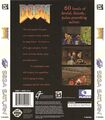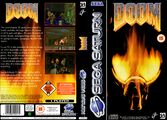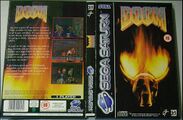Difference between revisions of "Doom (Saturn)"
From Sega Retro
| Line 36: | Line 36: | ||
| tectoy=18 | | tectoy=18 | ||
}} | }} | ||
| − | '''''Doom''''' (ドゥーム) for the [[Sega Saturn]] is a set of first person shooters originally released for IBM PC compatibles running DOS in the early 1990s. Despite its name, the package consists of two games; | + | '''''Doom''''' (ドゥーム) for the [[Sega Saturn]] is a set of first person shooters originally released for IBM PC compatibles running DOS in the early 1990s. Despite its name, the package consists of two games; ''The Ultimate Doom'' (a 1995 update of the 1993 game, ''Doom'') and its sequel ''Doom II: Hell on Earth'' (1994), alongside a few extra levels seen in a previous PlayStation version of this package. |
==Differences from PC Version== | ==Differences from PC Version== | ||
| − | The Sega Saturn version of ''Doom'' | + | The Sega Saturn version of ''Doom'' derives from the 1995 PlayStation version, which itself derives from the Atari Jaguar port of the game (as do most home versions of the era). On the Jaguar, several levels from the original ''Doom'' were visibly altered for performance reasons - this, and several minor changes carry through to the Saturn. |
| − | + | For the PlayStation version, significant changes were made to create a more "atmospheric" tone, including a different lighting system and the omission of the original MIDI soundtrack. Intermission scenes were dropped and some secret levels (notably the ''Wolfenstein 3D''-inspired levels of ''Doom II'') were dropped and replaced with new maps. Enemy placement is at times very different, and ''Doom II'''s super shotgun can be used in ''The Ultimate Doom'' levels. | |
| + | |||
| + | The Saturn port(s) builds on this, however it is thought to have been rushed, originally hitting North America in March 1997. A combination of poor frame rates, slower enemies (yet curiously faster reload times) and numerous missing visual and audio effects led it to be panned by critics, as did a missing multiplayer mode, despite being advertised on the box (along with 60 levels, when in reality there are 59). Also notable is the use of ''Final Doom'' screenshots from a completely different release not included here. | ||
| + | |||
| + | When brought to Europe, support for the [[Taisen Cable]] was added (despite the accessory not being officially released in the region), and when released in Japan in July, the speed was increased to help it try and match the PlayStation version (though it is still slower in comparison). The Japanese version also adjusts the soundtrack to bring it more in-line with Sony's version. | ||
==Production Credits== | ==Production Credits== | ||
Revision as of 13:05, 13 December 2015
- For the Sega 32X release, see Doom (32X)'.

| |||||
| Doom | |||||
|---|---|---|---|---|---|
| System(s): Sega Saturn | |||||
| Publisher: GT Interactive (US/EU), Soft Bank (JP) | |||||
| Developer: Rage Software | |||||
| Developer(s) of original games: id Software | |||||
| Sound driver: SCSP/CD-DA (17 tracks) | |||||
| Peripherals supported: Taisen Cable | |||||
| Genre: Shoot-'em-Up | |||||
| Number of players: 1-2 | |||||
| |||||
Doom (ドゥーム) for the Sega Saturn is a set of first person shooters originally released for IBM PC compatibles running DOS in the early 1990s. Despite its name, the package consists of two games; The Ultimate Doom (a 1995 update of the 1993 game, Doom) and its sequel Doom II: Hell on Earth (1994), alongside a few extra levels seen in a previous PlayStation version of this package.
Differences from PC Version
The Sega Saturn version of Doom derives from the 1995 PlayStation version, which itself derives from the Atari Jaguar port of the game (as do most home versions of the era). On the Jaguar, several levels from the original Doom were visibly altered for performance reasons - this, and several minor changes carry through to the Saturn.
For the PlayStation version, significant changes were made to create a more "atmospheric" tone, including a different lighting system and the omission of the original MIDI soundtrack. Intermission scenes were dropped and some secret levels (notably the Wolfenstein 3D-inspired levels of Doom II) were dropped and replaced with new maps. Enemy placement is at times very different, and Doom II's super shotgun can be used in The Ultimate Doom levels.
The Saturn port(s) builds on this, however it is thought to have been rushed, originally hitting North America in March 1997. A combination of poor frame rates, slower enemies (yet curiously faster reload times) and numerous missing visual and audio effects led it to be panned by critics, as did a missing multiplayer mode, despite being advertised on the box (along with 60 levels, when in reality there are 59). Also notable is the use of Final Doom screenshots from a completely different release not included here.
When brought to Europe, support for the Taisen Cable was added (despite the accessory not being officially released in the region), and when released in Japan in July, the speed was increased to help it try and match the PlayStation version (though it is still slower in comparison). The Japanese version also adjusts the soundtrack to bring it more in-line with Sony's version.
Production Credits
(US manual)
Programmers: John Carmack, John Romero, David Taylor, Michael John Cash
Artist: Adrian Carmack, Kevin Cloud
Level Designers: John Romero, Sandy Peterson, American McGee, Shawn Green
Development Support: Shawn Green
Biz: Jay Wilbur, Mike Wilson
Biz Assistant: Donna Jackson
Developed By: Rage Software
Programming: Jim Bagley, Alan Webb
Graphics: Simon Street, Ian Rickard
Sound: Steve Lord, Kev Bruce
Producer: John Heap
Promotional Material
Sega Saturn Magazine (JP) Print advertisement
Physical Scans
| Sega Retro Average | |||||||||||||||||||||||||||||||||||||||||||||||||||||||||||||||||||||||||||||||
|---|---|---|---|---|---|---|---|---|---|---|---|---|---|---|---|---|---|---|---|---|---|---|---|---|---|---|---|---|---|---|---|---|---|---|---|---|---|---|---|---|---|---|---|---|---|---|---|---|---|---|---|---|---|---|---|---|---|---|---|---|---|---|---|---|---|---|---|---|---|---|---|---|---|---|---|---|---|---|---|
|
| 56 | |
|---|---|
| Based on 15 reviews | |
NEC Retro has more information related to Doom
|
NEC Retro has more information related to Doom II
|
- ↑ 1.0 1.1 File:CVG UK 183.pdf, page 80 Cite error: Invalid
<ref>tag; name ":File:CVG UK 183.pdf_p80" defined multiple times with different content - ↑ 2.0 2.1 File:MeanMachinesSega53UK.pdf, page 66 Cite error: Invalid
<ref>tag; name ":File:MeanMachinesSega53UK.pdf_p66" defined multiple times with different content - ↑ File:SSM_UK_16.pdf, page 72
- ↑ File:SSM_JP_19970718_1997-24.pdf, page 175
- ↑ 5.0 5.1 Saturn no Game wa Sekai Ichi~i~i~i!: Satamaga Dokusha Race Zen Kiroku, SoftBank Publishing, page 15 Cite error: Invalid
<ref>tag; name ":File:SnGwSISDRZK Book JP.pdf_p15" defined multiple times with different content - ↑ Gambler, "4/1997" (PL; 1997-xx-xx), page 1
- ↑ GameFan, "Volume 5, Issue 3: March 1997" (US; 1997-xx-xx), page 29
- ↑ GamePro, "April 1997" (US; 1997-xx-xx), page 91
- ↑ Hobby Consolas, "Diciembre 1996" (ES; 199x-xx-xx), page 112
- ↑ Player One, "Décembre 1996" (FR; 1996-xx-xx), page 65
- ↑ Saturn Fan, "1997 No. 17" (JP; 1997-08-29), page 84
- ↑ Secret Service, "Kwiecień 1997" (PL; 1997-xx-xx), page 64
- ↑ Sega Power, "January 1997" (UK; 1996-12-19), page 30
- ↑ Sega Saturn Magazine, "February 1997" (UK; 1997-01-16), page 72
- ↑ Sega Saturn Magazine, "1997-24 (1997-07-18)" (JP; 1997-07-04), page 175
- ↑ Super Juegos, "Febrero 1997" (ES; 1997-0x-xx), page 98
- ↑ Total Saturn, "Volume One Issue Six" (UK; 1997-02-28), page 32
- Pages with reference errors
- No title screen
- Taisen Cable-compatible games
- 1-2 player games
- Old content rating field
- Use romtable template
- All games
- Old-style rating (cvg)
- Use magref
- Old-style rating (gamepro)
- Rating without source
- Old-style rating (gamesmaster)
- Rating without PDF source
- Old-style rating (mms)
- Old-style rating (segapower)
- Old-style rating (ssm)
- Old-style rating (ssmjp)
- Old-style rating (ssmjp r)
- Old-style rating (ssmjp source r)
- Old-style rating (superjuegos)
- Update ratings template
- 8 old ratings










